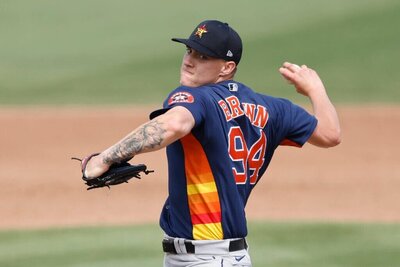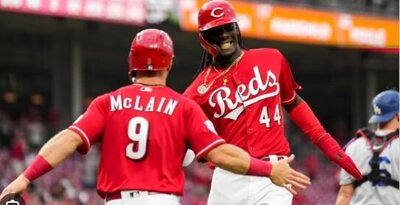1. David Robertson (RP, NYY) - The addition of a cutter to Robertson's pitch repertoire last season transformed him from a solid middle inning reliever into an un-hittable dominating force in the late innings of games. His strikeout rate leaped to 13.5 K/9 and he started getting groundballs upwards of 46 percent of the time. His control continued to be an issue (4.73 BB/9) but when you're striking out nearly 37 percent of the batters you're facing, what's a couple of walks? With Mariano Rivera out of the picture for the season, Robertson should be the pitcher the Yankees use to close out games. He has a Swinging Strike rate over 10 percent and batters struggle to make contact (74.7 percent Contact rate), and when they do it rarely results in a hit (.179 Batting Average Against). Manager Joe Girardi hasn't named a replacement for Rivera just yet, but the smart money is on Robertson. Even if Rafael Soriano gets the nod at first because of his experience in the role, I'm willing to wager that Robinson's superior skill set wins out.
2. Rafael Soriano (RP, NY) - If the Yankees decide that experience matters then they'll go with Soriano to close over David Robertson. Soriano closed out 72 games over a two-year period with Braves and Rays, including a huge 45 save season in 2010. Since coming to the Yankees as a free agent after that magical year with Tampa Bay, Soriano has been mediocre at best. This season, his strikeout rate is at a career-low while his walk rate soared to a career-high. In addition, he is giving up hits at the highest rate of his career, with his batting average against currently sitting at an unacceptable .306. It's also worth noting that since joining the Yankees, Soriano has all but given up on his fastball, which continues to lose velocity with each passing season. Soriano used to throw the heater up around 95 MPH. These days, he's tossing it in there around 91 MPH and there is far less movement on the pitch than there used to be. In the final analysis, I believe that Soriano is ill-suited for the closers job. He no longer has the stuff to be a dominating pitcher, and he is clearly in the decline phase of his career. The Yankees may go with him based solely on his two years of experience, but they'd be better served using Robertson at this point.
3. Chris Sale (SP/RP, CHW) - The White Sox announced that they are no longer going to mess with Sergio Santos or Matt Thornton in the closer's job. Instead, they are going to remove Chris Sale from the starting rotation and return him to the bullpen. This is bad news for Fantasy owners that drafted Sale as a starting pitcher, as his overall value will take a hit with the change in role. After all, there is a limit to how much he can gain in value as a closer. He's been downright dominant as a starter, posting a 3-1 record with a 2.81 ERA and 1.00 WHIP. Granted, he is striking out fewer batters per nine innings this season (8.1 K/9 as opposed to 10 K/9 in 2011), but he's also walking fewer batters (2.25 BB/9 as opposed to 3.42 BB/9 last year). However, there is every reason to believe that Sale will continue to thrive out of the bullpen. He stepped into the closers role last season, saving 8 of 10 chances. Overall, he pitched 79 innings out of the bullpen with an ERA of 2.81. Sale would have likely been on an innings limit this season anyway, so the move to the pen makes sense, just not this soon. But he still has the same electric stuff, and the Pale Hose still have enough starting pitching to get the ball to Sale in the ninth inning. Therefore, as long as Sale can make the mental adjustment back to closing games, there should be no problem.
4. Albert Pujols - Far be it from me to diagnose Pujols' problems at the plate, but the numbers do tell their story. Pujols has a career O-Swing of 21.8 percent. Over the past three seasons, that metric has slowly crept upwards each year. In 2009, he was at 22.9 percent, right around his current career average. Since then, his O-Swing has grown from 27.5 percent in 2010, to 31.8 percent last season and finally to a whopping 39.8 percent, where it currently stands. Strangely, he is still making elite-level contact (88.8 percent) and both his F-Strike percentage (52.6 percent) and Swinging Strike percentage (5.7 percent) remain flat at or near career normal. Still, his walk rate is greatly diminished at just 5.3 percent, well off his career average 13 percent, and his strikeout rate is at 13.2 percent. Call me crazy, but Pujols either has a problem with his eyes, or some underlying injury that he's hiding from everyone.
5. Dustin Ackley (2B, SEA) - The shakeup to the Mariners lineup creates an opportunity for Dustin Ackley to do what he does best, get on base. In two seasons at Triple-A Tacoma, Ackley posted an OBP of .387. During his second season there at age 23, Ackley actually walked more than he struck out, putting up a K:BB ratio of 38:55. While he has yet to accomplish such a feat at the major league level, he did put up a respectable OBP of .348 last season over 376 PA. His K:BB ratio was 79:40 during 90 major league games. This season, Ackley is struggling a bit to get on base, but there are some good signs among his peripherals. First, he is making excellent contact so far. In fact, his Contact rate would be considered elite by most at 89.2 percent. The problem seems to be that he doesn't take the bat off his shoulders. His overall Swing percentage is just 40.3 percent, well below the league average of 45.1 percent. The rest of his plate discipline metrics are within league norms. Perhaps now that Ackley is at the top of the lineup, where he is expected to be aggressive about getting on base, we'll begin to see him attack the ball. Of course, should Ackley fail at the leadoff role, Ichiro Suzuki would be pleased to step in and take over the job.
There are over 100 player news blurbs posted in the member area each morning. Members can read the rest of today's player news by clicking here. Not a member? Join today.


































